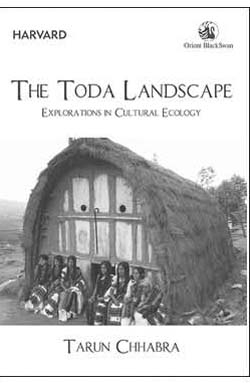This monograph is the product of two decades of research by an amateur ethnographer who, based in the Nilgiri Hills, has devoted time both to the study and support of the Toda community. Chhabra’s work with the Todas crosses the spheres of research, advocacy and friendship. In 1992, he established the Toda Nalvazhvu Sangam (the Toda Welfare Society) to mediate between the local government and the community. Much of the monograph has been published elsewhere and the chapters remain relatively discrete but exceptionally rich explorations of particular facets of the Toda community’s cultural and religious life set carefully within the landscape, flora and fauna of the Nilgiri hills. The chapters describe rituals, clothing, the sacred geographies of the hills, the material cultures of the community and even the particular importance of the honey bee for the Toda community. The extent of the mythologies, placenames, songs, embroidery designs and poems that are carefully documented in this book is redoubtable and very obviously the result of many years of arduous and exacting labour. Chhabra describes both occasional and everyday sacred practices through which the Toda communities reiterate their social order and their place within the landscape of the Nilgiris. Much of the text reads, enjoyably, like a travelogue, there are reminiscences on particular events and encounters and reflections on personal journeys undertaken. Seasonal migrations and pilgrimages are richly described as are the places, plants and animals encountered by Chhabra. He orients everything across the sacred landscapes of the Todas, evoking his own engagement with and submission to the divine: ‘The divine energy levels from my pilgrimage were so intense that the vibrations persisted strongly within my body for a month afterwards’ (p. 37). Across these landscapes, past and present, sacred and divine coexist in an order carefully delineated by language, memory and living custom.
Chabbra’s research stresses the constant nature of the inhabitations, sacred practices and clothing he describes. Terms such as ‘time immemorial’, ‘considerable antiquity’ and ‘ancient custom’ are common throughout the text. Palpable cultural changes, such as conversion of some Todas to Christianity or the adoption of vegetarianism are mentioned in passing but left unexplored. It would have been fascinating to know how the Todas understand their changed and changing cultural, social and economic landscape.
Historical context has only a fleeting presence in the text. The colonial history of the hills is summed up in a couple of pages of anecdote taken from British history. Small mentions are given to changes in the past two centuries, for example the acquisition and administration of Toda land rights but resolutely imperial texts such as Price’s 1902 Ootacamund: A History, are relied upon. In the absence of research into the systemic, contingent and dramatic transformation of the Nilgiri hills in the nineteenth and twentieth centuries, Chhabra speculates, rather generously, that perhaps, ‘the British … realised that, because the Toda way of life was so closely linked to the rhythms of nature, it was best to leave major hamlets and sacred sites intact’ (p. 28). It would have been fascinating to know more about the relationship between civil authority, economy and non-Toda cultures on the hills. There is some passing anecdote—for example that one Collector asked for her office to be decorated entirely with Toda embroidery— but a greater sense of the web of relationships in which the Todas maintain their cultural ecologies would have enriched the monograph. The text raises some beguiling questions, for example, that the Toda’s ‘vested interest in preserving their natural environment’ has led them to limit their population (p. 47). By what means have they done so?

